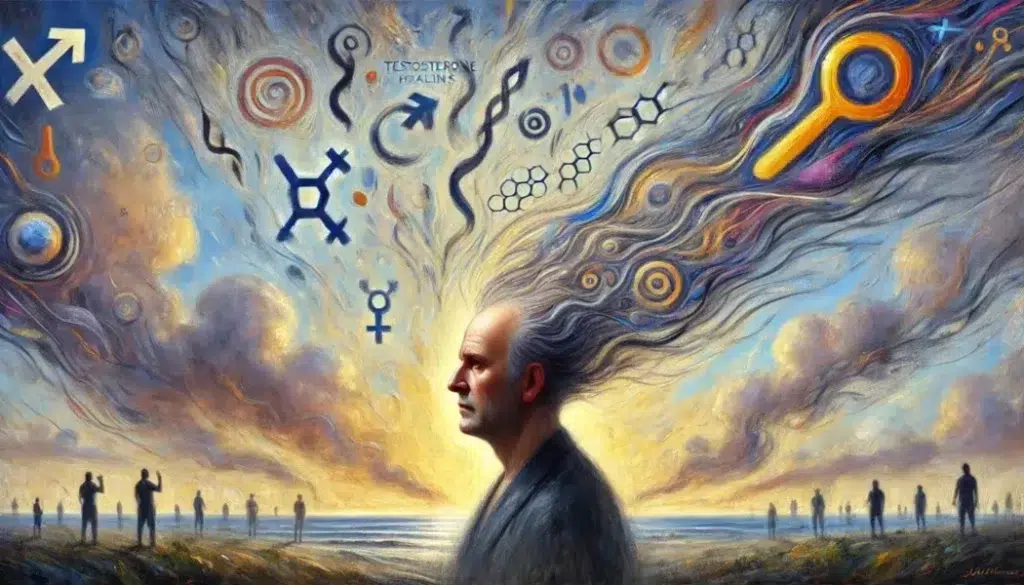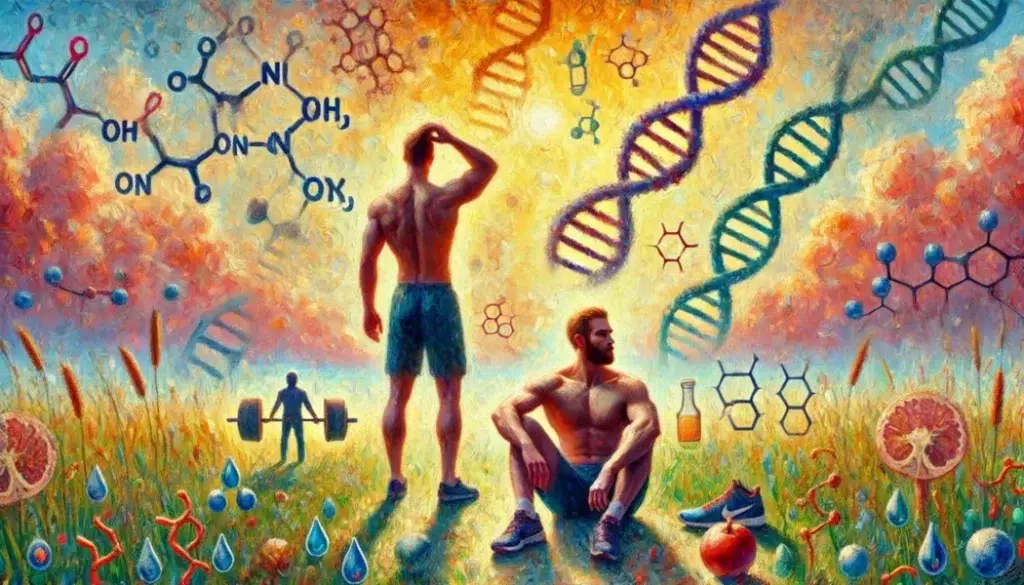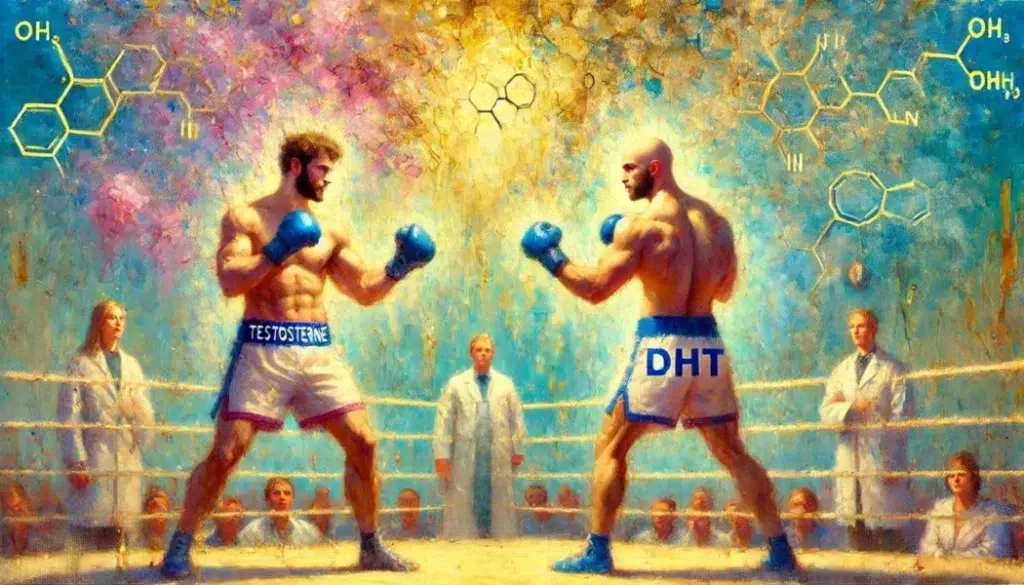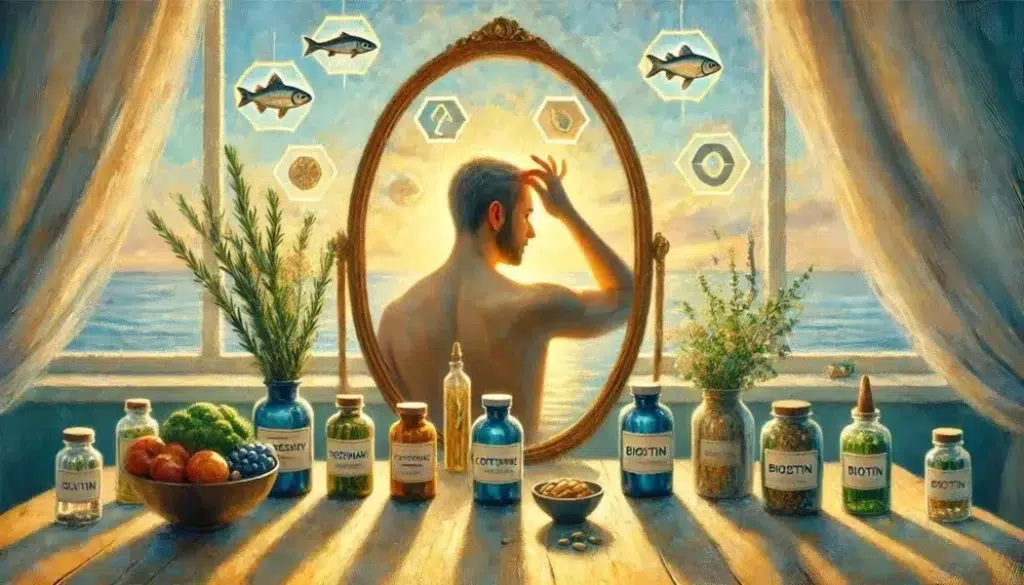🔍 Testosterone and Hair Loss: Where Did the Rumor Start?
Testosterone has long been the scapegoat for male hair loss. Ask around or do a quick online search, and you’ll find countless posts blaming “high testosterone” for receding hairlines and thinning crowns. The idea sounds logical at first—after all, men typically have more testosterone than women, and they also lose hair more frequently. But here’s the catch: correlation isn’t causation, and the real story is far more nuanced.
The confusion likely stems from the fact that testosterone is a precursor to DHT (dihydrotestosterone), a more potent androgen linked to hair loss in genetically sensitive individuals. Once testosterone is converted into DHT by the enzyme 5-alpha-reductase, it can bind to hair follicle receptors, shortening their growth cycle. But that doesn’t mean high testosterone automatically equals hair loss. Many men with elevated testosterone levels have full, thick hair—and others with average levels still go bald.

So where did this widespread belief come from? Most likely, it’s a case of oversimplified science getting repackaged into a convenient myth. Popular media and supplement marketing love a “villain,” and testosterone has often been miscast in that role. But when we dig into the research, it becomes clear that the problem isn’t testosterone itself—it’s how your body processes and reacts to it.
🧬 Understanding the Real Culprit: DHT and Genetic Sensitivity
Let’s get one thing straight — DHT is not inherently bad. In fact, it plays a crucial role in male development, influencing everything from facial hair to libido. But when it comes to the scalp, DHT can become a problem — not because it’s too strong, but because certain hair follicles are too sensitive to it. And that sensitivity? It’s written in your genes.
Androgenetic alopecia—also known as male pattern baldness—isn’t caused by DHT alone. It happens when hair follicles are genetically predisposed to shrink in the presence of DHT. Over time, these follicles produce thinner and weaker hairs until they eventually stop altogether. It’s not about the amount of DHT floating around in your system, but how your follicles respond to it.

This explains why two men with similar hormone levels can have completely different experiences: one with a thick mane well into his sixties, and the other with noticeable thinning by his twenties. The key variable is genetic sensitivity, not testosterone quantity. That’s why blaming testosterone across the board doesn’t hold up scientifically—it overshadows the true cause and leads people to fear the wrong thing.
⚖️ High Testosterone = More Hair Loss? Not Necessarily
It’s a common assumption: if DHT comes from testosterone, then more testosterone must mean more DHT—and therefore more hair loss. But that’s not how the body works. In reality, the relationship between testosterone and hair loss is not linear, and it’s certainly not universal. Many men with high testosterone levels show no signs of baldness, while others with lower levels begin losing hair in their twenties.
Several studies have shown that serum testosterone levels don’t reliably predict hair loss patterns. What matters more is the activity of 5-alpha-reductase and how efficiently it converts testosterone into DHT—plus how sensitive your follicles are to DHT once it’s present. In other words, your enzyme activity and follicle sensitivity matter far more than your raw testosterone levels

Even elite athletes and bodybuilders, who often have elevated testosterone (naturally or otherwise), don’t all suffer from hair loss. Some do, yes—but not all. And in many cases, lifestyle factors like chronic stress, inflammation, poor nutrition, and lack of proper scalp care have just as much impact on hair health as hormone levels. Testosterone may influence hair indirectly, but it’s not the root of the problem—it’s just part of a much larger picture.
🛡️ How to Manage DHT Without Ruining Your Hormonal Balance
If DHT is the real issue, not testosterone, then it makes sense to manage DHT directly—but with precision. The goal isn’t to wipe out your hormones, but to create a scalp environment where follicles can thrive, even in the presence of androgens. That’s why modern hair loss strategies focus on selectively blocking DHT in the scalp, rather than altering your entire hormonal system.
One of the most well-known approaches is finasteride, a medication that inhibits 5-alpha-reductase, the enzyme that converts testosterone into DHT. Studies show that finasteride can significantly slow hair loss and even promote regrowth in some men. But like any medication, it comes with potential side effects—including reduced libido and hormonal shifts—which is why it’s essential to discuss options with a healthcare provider before starting treatment.
For those looking for a gentler approach, natural DHT blockers are gaining popularity. Ingredients like saw palmetto, nettle root extract, pumpkin seed oil, and zinc have been studied for their ability to reduce DHT activity at the follicular level—without affecting systemic hormone levels. While results may vary, many of these compounds are included in top-rated shampoos, conditioners, and supplements that users report as effective over time.

We researched user reviews and available clinical data, and found that some of the most recommended DHT-targeting formulas include combinations of herbal extracts, amino acids, and vitamins that support overall scalp health. While not as aggressive as pharmaceutical options, these products are often well-tolerated and can be a smart first step—or a complementary option—for those hesitant about medication.
🧴 What Really Works: Building a Scalp-Friendly Routine
Managing DHT is just one piece of the puzzle. Your daily habits and product choices play a massive role in hair health, especially if your follicles are genetically sensitive. You can’t change your DNA, but you can create conditions where your hair has the best possible chance to grow stronger, longer, and healthier.
Start with the basics: a shampoo and conditioner designed to support scalp health and manage DHT. The best-reviewed options typically contain ingredients like rosemary extract, caffeine, biotin, and ketoconazole—each shown in studies or user reports to support healthier hair. We looked at user ratings across multiple platforms, and products that combine these ingredients tend to be the most consistently praised.
Adding a scalp massage routine can further enhance your efforts. Just a few minutes a day with your fingertips or a manual scalp massager can boost blood flow to the follicles, helping deliver nutrients and clear out excess DHT at the root level. This simple habit is often underrated but has shown benefits in both anecdotal reports and small-scale clinical studies.

Don’t forget lifestyle: chronic stress, poor sleep, and nutrient deficiencies all contribute to hair loss by disrupting hormonal balance. Make sure your diet is rich in zinc, vitamin D, omega-3s, and protein, or consider a high-quality supplement that fills in any nutritional gaps. Several combinations have been positively reviewed by users for supporting not just hair health, but also energy and focus—important if you’re managing multiple stressors at once.
💡 Final Thoughts: Don’t Fear Testosterone—Outsmart DHT
If you’ve been blaming testosterone for your hair loss, you’re not alone—but now you know better. Testosterone is not the enemy. In fact, it’s essential for your vitality, confidence, and overall well-being. The real challenge lies in how your body processes it—specifically, how your follicles react to DHT. And that’s something you can influence.
Whether you choose medical treatments like finasteride, natural DHT blockers, or a complete scalp-care routine, the most important element is consistency rooted in understanding.Hair regrowth may begin overnight—but it takes time before you see it in the mirror. That’s why trust and consistency matter more than speed. Results always follow when the routine is right.
We’ve researched the science, reviewed real user experiences, and highlighted the most commonly recommended approaches—not to sell you hope in a bottle, but to show you that results come from clarity and action. Testosterone isn’t the villain—it’s time we stop fearing it and start focusing on what actually works
Stay with us — the best is yet to come.
By following our advice, you’re doing the most you can for your hair.
Be the first to know when we publish new guides, tests, and proven strategies for stronger, healthier hair.
👉 Visit the About Me page to learn more about my journey, mission, and why helping people with hair health is so personal to me.
Want healthier, stronger hair? Discover 8 science-backed habits that protect your scalp and boost natural growth. Get your free PDF guide today!
Disclaimer: This article is for informational purposes only and is not a substitute for professional medical advice. Sensitive claims are supported with scientific references, and full product details can always be found on the official websites of the respective manufacturers or distributors.
Some links in this article are affiliate links. If you choose to make a purchase through them, I may earn a small commission at no extra cost to you — helping me keep HairGrowGenius running. Thank you for your support!

❓ FAQ: Testosterone and Hair Loss — What You Really Need to Know
🧪 Does high testosterone directly cause hair loss?
Not directly. It’s not testosterone itself but how your body converts it into DHT (dihydrotestosterone) that can trigger hair loss. Some people are genetically more sensitive to DHT.
💊 Should I stop working out or taking testosterone supplements?
No — exercise and healthy testosterone levels are important for overall health. But if you’re taking anabolic steroids or synthetic testosterone, it may increase DHT and speed up hair loss.
🧬 Can I be genetically sensitive to DHT even with normal testosterone levels?
Yes. Even men with average testosterone levels can experience hair loss if their hair follicles are genetically more sensitive to DHT’s effects.
🌿 Are there ways to block DHT naturally without affecting testosterone?
Yes. Natural DHT blockers like saw palmetto, pumpkin seed oil, and green tea extract can help reduce DHT activity without significantly altering your testosterone levels.
🧾 Last updated: June 2025 based on latest research.


Leave a Reply